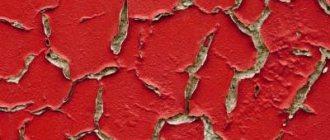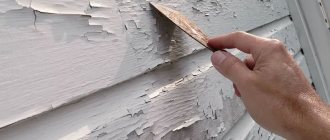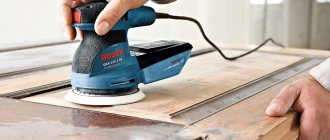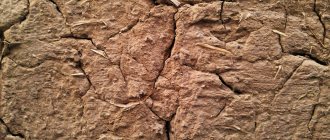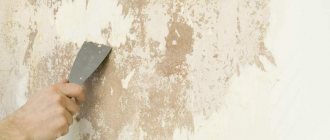Reliable methods and means for removing paint from metal
Often a person is faced with the need to remove paint from metal. Any coloring composition deteriorates over time, and rust may appear through it.
Sometimes paint stains appear on the surface of a product by accident. To cope with the task, you need to act carefully, following the advice of professionals.
In this article you will learn how to remove old paint from metal at home.
Preparatory stage
Before you start work, you need to prepare properly . This complex includes:
Purchase of tools and household chemicals. Depending on the chosen cleaning method, you will need: a grinding machine, a hair dryer, paint remover, a spatula, kerosene, a brush, etc.- Protect surrounding objects from dust and other contaminants. For this, polyethylene film is used.
- Prepare personal protective equipment. The classic set includes: gloves, construction glasses, respirator.
- Prepare the metal surface for upcoming cleaning. Dust and other contaminants are removed from it. If household chemicals are used, you can clean the paint with a stiff-bristled brush. This will increase solvent diffusion and speed up the reaction.
When all the preparatory steps are completed, you can begin to work.
Instructions for using the remover
Each wash is accompanied by instructions from the manufacturer, taking into account the features of the specific composition (you need to study it before use). It is necessary to prepare personal protective equipment - a respirator, goggles and gloves to protect yourself from toxic fumes and droplets of the substance on the skin.
To remove old paint you will need the following tools and materials:
- suitable type of wash;
- solvent;
- primer;
- brush or spray if the remover is liquid;
- sandpaper;
- putty knife.
Before starting work, the surface must be cleaned of contaminants and degreased so that only the paint reacts with the chemical and the effectiveness of the product is better. Then you can start cleaning the metal:
- The product is applied to the surface in the amount specified in the instructions and distributed over it in an even layer.
- The metal is covered with plastic film.
- You should wait a while for the product to take effect. Depending on the manufacturer, type of paintwork material, thickness of its layer, air temperature and other factors, this can take from several minutes to an hour.
- When the coating begins to swell and lag behind the base, the paint is scraped off with a spatula.
- The remaining material is erased with sandpaper.
- The surface is wiped with solvent and primed for new painting.
How to remove from the gate?
To remove paint from metal gates, you need to perform the following procedure:
After such cleaning, the gate will be completely ready for further processing.
You need to clean the paint on a sunny day. Rain may cause work to stop.
Advantages and disadvantages
Each method has its own characteristics that a person must take into account when performing repair work.
Advantages and disadvantages of methods
| Name | pros | Minuses |
| Mechanical | Removing old layers of thick paint Possibility of using cheap materials Elimination of formed corrosion | Labor intensity Duration The presence of a huge amount of dust during work Depending on the choice of abrasive, there is a possibility of damage to the product |
| Thermal | Processing of products of any shape Shorter procedure time Possibility of cleaning products whose material does not tolerate vibration well | The need to combine with a mechanical method High fire risk Release of toxic substances into the environment Reduction in the strength of some metals or the formation of scale |
| Chemical | Ease of manipulation No damage to the product Fast cleaning Corrosion removal Ability to clean objects of any shape and in hard-to-reach places | High price It is impossible to remove paint from metal that has been on its surface for more than 2-3 years The need for repeated application of solvent with a high thickness of the paint and varnish composition Presence of grease stains on the cleaned surface after the procedure |
Features of removing different types of paint and varnish products
Any paint can be removed mechanically, thermally or chemically, but sometimes certain methods are preferable.
| Paint type | Removal method |
| Oily | A thin layer can be removed using any remover, for example, using acetone. A thick old layer requires mechanical cleaning. The most difficult areas are burned out. |
| Acrylic | The paint responds well to solvents and removers. To increase the efficiency of work, the surface should be cleaned. |
| Powder | The most effective way to remove paint is to burn it. If this method cannot be used for the product, then they resort to chemical agents, for example Fail-4 or Remover. |
| Aerosol (from a can) | You can get rid of such paint using sandpaper or a wire brush. For high-quality removal of the composition, the surface is treated with a solvent. |
The most common mistakes
When removing paint from a metal surface, you should avoid the following mistakes:
Using a hair dryer or torch indoors. When heated, paint will release toxins, so poisoning cannot be avoided. Such work should be carried out in the fresh air.- Firing of brass and cast iron products. When heated, these metals become covered with scale and become brittle. This will lead to their rapid destruction.
- Working without personal protective equipment. Failure to follow basic safety precautions increases the risk of injury.
- Mechanical cleaning of thin sheets of metal. Pressing too hard may damage them. The product will lose its shape, or dents will appear on it, which will be difficult to straighten.
In order to avoid mistakes when performing work, you need to know what metal the product is made of and what type of paint it is coated with.
Types of washes
There are several types of flushing liquids, which are classified according to the specifics of their application:
- Preparations for removing water-based and oil-based paints.
- Universal removers designed to remove any coating on all types of materials.
- Compositions for removing powder coatings.
- Express washes characterized by fast action.
- Removers for metal.
You can remove paint from a metal surface not only with a specialized composition, but also with a universal one, as well as an express remover. If we are talking about powder coating, then you will also need the appropriate type of remover.
Important Tips
When removing paint from metal, you should use the following recommendations:
- Observe safety precautions. Hands, respiratory organs and eyes need protection.
- Take care of cleanliness. Less dust will form if you spray the surface with water before mechanical cleaning.
- Do not overheat the paint to prevent it from catching fire. You can start applying the metal remover or solvent only after it has cooled down. Such liquids are flammable.
- In order not to damage the surrounding surfaces, they are covered with cloth.
How to remove old paint from metal
How to remove old paint from metal? This question arises when the previous decorative layer becomes unusable. The coating can deteriorate for various reasons, but the main factor is constant contact of the surface with oxygen. You can remove the old layer in various ways, but the method should take into account the specific situation and not take much time.
We use sandpaper
The most ancient method by which metal surfaces are cleaned. How to remove the coating if not with your hands? Indeed, this method is quite suitable in cases where the paint needs to be removed locally. Paper of various grains and a little persistence will help you remove the paint layer, although it will take quite a lot of time. To protect yourself from the abundant release of dust that accompanies the process, moisten the surface to be cleaned with water. However, this will require you to use waterproof sandpaper, which is not always possible. In addition, it is not practical to use sandpaper on large areas.
How to remove paint?
Removal of a worn out or outdated protective and decorative layer can be carried out in various ways, during which certain materials and tools will be used. The following options are considered the most popular and effective:
- Use of available heating devices. Thermal exposure allows you to quickly remove the old composition, but can have a negative effect on the surface. For work, use a hair dryer, blowtorch or gas burner. If necessary, parts can be immersed in a furnace or fire.
If the surface has been repeatedly coated with paint, then several approaches to applying the remover will be required.
The use of any tool or material must be done with caution; harm can be caused not only to the metal, but also to health.
Removing all types of paints
Removal products:
- Iodine solution. To do this, add 200 milliliters of iodine to a 10-liter container of water. Stir the solution well and apply it to the surface. After some time, cracks will appear.
- Soap solution. The recipe involves using regular laundry soap. Take a bar of soap, grate it, mix the resulting mass with water.
- A solution of ammonia. To make it you will need 250 milliliters of ammonia, 2 kilograms of chalk, and a liter of water. The solution turns out to be a porridge-like consistency. Apply the resulting mass to the surface. After a few hours, the old coating will begin to peel off.
- Dichloroethane and chloroform work well with latex coatings. Any of these components can be safely added to the solution.
- If the surface is painted with acrylic paints and varnish, you can add alcohol (vodka) or salicylic acid to it to improve the working qualities of the solution.
Removing paint using the thermal method
This technology involves the use of available devices. The principle is that under the influence of high temperatures the coating softens, after which it can be removed immediately. When using tools with an open flame, a burning effect is created, due to which the paint burns, freeing the base for subsequent cleaning.
Work order:
- The condition of the area being cleaned is assessed. If the structure is easily removable, then it is better to dismantle it, this will allow the work to be completed more safely. If this is not possible, ensure that adjacent areas will not be exposed to high temperatures.
- All excess is removed, and adjacent surfaces are protected if necessary. Asbestos boards can be used for this.
- The item is thoroughly cleaned of dirt and dust, washed with water and dried.
- The heating device is being prepared. It is better to use a hair dryer, as it is much safer than a gas torch or blowtorch. You also need to have a wire brush and spatula. To avoid unpleasant consequences, protective equipment is provided: gloves, goggles, respirator.
- Heating occurs evenly. Initially, a large area is captured to make the coating easier to remove, then individual zones are heated. As soon as the structure of the layer being removed becomes noticeably softer, a spatula or brush is used.
- To achieve the best result, all movements must be interconnected and consistent: heating - removal.
- To completely remove residues, a solvent is used. The main thing is that the base should not be very hot.
This method is suitable when you need to clean an oil-based paint composition. It is better to carry out work outdoors or in a constantly ventilated area.
On a note! Heating radiators made of cast iron, brass and aluminum, as well as thin sheets and forged decorative elements that are parts of a composition made of other materials, cannot be subjected to heat treatment.
Thermal method
A blowtorch, hair dryer or gas torch will help remove several layers of stubborn paint. The metal surface is washed, removing dust and dirt, and after drying it is treated with fire or a stream of hot air.
High temperatures soften the old coating. It separates from the metal surface and bubbles appear. The heated paint is immediately removed with a spatula or knife. You need to hold a blowtorch in your left hand, and peel off the coating with your right.
You can work together to finish faster.
There should be no flammable objects made of wood, paper or fabric near the surface to be treated. The paint is removed carefully so that hot particles do not get on the skin. The softened coating eats into the epithelium and leaves a burn that does not heal for a long time.
Do not burn cast iron or brass products. Some types of metal become coated with scale, become brittle, and are destroyed when treated with a blowtorch. On others, cracks appear due to uneven heating.
Do not use a gas burner or hair dryer indoors. The paint emits toxic substances, so work is carried out outdoors or in a ventilated area.
The layer of old coating can be removed quickly and efficiently using mechanical or chemical methods. Removers and brushes do not destroy metal surfaces and do not leave dents or cracks. The thermal option is rarely used and all the pros and cons of such cleansing must be weighed.
Be sure to wear protective gloves and a respirator to prevent hazardous fumes and chemical toxins from entering your respiratory system or on your skin. Before applying the remover, you need to carry out preparatory work: clean the surface of dirt and dust with plain water or a detergent. Apply the composition to the old paint for a period of time recommended by the manufacturer.
The product is applied in a thin layer of a few millimeters to the surface. Products for removing old paint from metal surfaces? Once peeling begins, begin removing the old paint layer with a putty knife.
After chemical treatment, the coating will peel off in layers and be easily removed.
A heat gun can also help if the surface can be heated strongly, which is not possible when processing many communication pipes. You need to bring it to the surface, the old paint will begin to peel off as it heats up, and all that remains is to remove it with a spatula. When working with these tools, you need to be very careful not to burn your hands on the hot metal . After this method, scale forms on the surface of the metal, which must be cleaned off.
Burning out the coating in such ways is definitely not suitable for sheet iron, since it is deformed by local heating, and for cast iron products, which can crack.
The range of metal brushes, as well as sandpaper, pleases with its diversity. And their price is low. They differ in hardness and are good at removing old paint along with rust.
After treating the problem area with a brush, it is advisable to go over it with sandpaper to remove any remaining roughness.
This method is most popular when it comes to a relatively flat surface. You can remove old paint from metal manually using sandpaper or a wire brush, or using a power tool, for example, using a special attachment on a drill.
There are also disadvantages: such equipment is very expensive and the cleaning process itself is difficult to control. That is, there is a danger of damaging the top layer of metal when removing old paint. Thus, sandblasting work in specially equipped rooms by the hands of experienced specialists.
Cleaning with abrasives
The tools used are drills, grinders, and grinders. The choice of a suitable nozzle, which must have an abrasive coating, is very important. To work in hard-to-reach places and with small parts, it is better to use the manual method: sandpaper is used independently or mounted on a special block.
It happens that it does not take much time to remove paint from metal when using the mechanical method, when the surface has a large number of peelings and blisters as a result of exposure to rust. In this case, a spatula and a knife are used. The main thing is to subject the base to thorough cleaning and anti-corrosion treatment.
- The place is prepared, everything unnecessary is removed. A respirator, gloves and goggles are used as protection.
- Removal begins from the selected area. It is better to move systematically, clearing the entire area without skipping.
- Different types of tools and abrasives have different effects on the surface. If the paint is applied in a thick layer or is well absorbed, the process begins with the roughest products, then the nozzle is changed.
- Due to the formation of dust and dirt, it is recommended to spray the treated area with water from a spray bottle. This method is suitable when using attachments in the form of brushes, disks or petal circles.
Strong mechanical impact can damage the base, so tools are used for rough cleaning. For parts that require careful processing, the manual method is chosen.
Precautions and simple method
Some metal products are quite fragile, so they cannot be processed with a blowtorch or cleaned with tools with abrasive components. Others tolerate hard brushes, sandpaper and even a hair dryer just fine. The method for removing the protective suspension is chosen depending on the thickness and composition of the base, as well as the type of paint itself.
The most economical method is mechanical. You will need a rigid stainless steel spatula or a kitchen knife. The main thing is that the tool has a sharp blade.
The painted surface is carefully inspected and a weak spot is found where the coating is swollen or cracked. The protective layer is pryed off with the selected tool and removed, trying to capture rust, if any.
The second stage of the mechanical method is grinding. You need to arm yourself with coarse sandpaper with water-repellent properties. If you take a simple variety, it will quickly wear out and become unusable.
The workpiece is fixed on a block of hard plastic or wood to make it more convenient to grind the metal and level it. The base, which is treated with sandpaper, is moistened with cold water. Removing old paint from the facade of a wooden house?
It is advisable to use a spray bottle so that the liquid is evenly distributed over the item. Water ensures the sliding of the abrasive surface and does not allow dirt and rust particles to rise into the air.
Repair work will take a long time if you have to clean an iron gate or fence. In such situations, the spatula is replaced with a grinder or drill. You will need a nozzle with hard bristles.
It is put on a power tool and the cast iron or iron product is polished until the layer of protective suspension disappears.
The result is secured with anti-corrosion impregnations, which fill small cracks and chips left after mechanical cleaning. Items that are planned to be painted again must be treated with a primer.
The method has several significant disadvantages:
- A drill or putty knife leaves indentations on thin-walled objects.
- Stubborn paint is difficult to remove mechanically.
- During operation, dust consisting of old coating, metal particles and rust rises into the air. If a person does not use a respirator and safety glasses, substances enter the mucous membranes of the eyes and nasopharynx, causing irritation.
If you need to clean large objects with thick walls, such as pipes, it is recommended to call a specialist with sandblasting equipment. The metal surface is treated with a jet of fine abrasive, which removes both paint and rust.
Chemical removal
A simple but unsafe method. The chemical option allows you to quickly and efficiently wash off water-based acrylic or other polymer compositions, as well as organic paints. Various types of products are used for work. Aerosols have proven themselves well; with their help you can easily treat the desired area.
Attention! If you need to clean brass or other decorative parts, first boil them in a soapy solution. Paint removal is done manually.
When working at home, it is advisable to take care of the health of others, animals and indoor plants. All procedures are carried out in a ventilated area wearing gloves, a respirator and safety glasses.
- The surface to be treated is thoroughly cleaned and washed, and after drying, degreased.
- Adjacent areas are closed, unnecessary items are removed.
- The chemical reagent is applied generously and thoroughly. An aerosol or liquid composition can be used for treatment. For the second option you need a brush.
- The product is covered with plastic film, this will improve the reaction.
- Depending on the manufacturer’s recommendation, you should then wait from 1 to 10 hours, and then remove the swollen layer using a spatula and brush.
- The surface is immediately washed with solvent and water, otherwise there is a high probability that the composition will damage the metal structure.
This product is also suitable for cleaning powder paint, but it is better to choose more caustic compounds.
Chemical options
Metal objects with a relief surface are treated with solvents. They are:
- universal;
- substances for ferrous and non-ferrous metals;
- multifunctional, removing paint along with putty and primer;
- oil-based coating removers.
Tip: It is better to buy remover at a hardware store. Powders and emulsions for removing paint from metal are also sold in car dealerships, but there they cost two to three times more.
Solvents soften the old coating, but you will have to separate it from the base with a stiff-bristled brush or spatula. A person who has chosen the chemical method must stock up on a respirator, safety glasses and rubber gloves. You will need a special suit and shoes.
Apply the remover in a thick layer using a brush. The paint is removed in several stages:
- The metal surface is wiped with a damp cloth to remove dirt, then disinfected.
- Treat the prepared item with a solvent and cover it with plastic wrap so that the substance is better absorbed into the old coating.
- Timed for 5–20 minutes. The time depends on the type of remover and the thickness of the paint layer.
- The soft covering is torn off with a spatula and swept into a heap so as not to be trampled into the ground or floor.
- Remains of paint are removed with a stiff brush with metal bristles.
The surface must be wiped with special compounds, for example, mineral kerosene, to remove the solvent. A product to remove old paint from window frames? The substance must not be left on the metal base, otherwise the new layer of paint will not be able to adhere and will fall off.
Acetone can soften old coating. Soak a rag or gauze with the liquid and apply it to a metal surface. Cover the top with plastic film and secure the structure with tape.
Leave for 10–12 hours for the acetone to absorb and begin to work. The fabric is removed gradually, the paint is immediately cleaned off so that it does not have time to harden.
The cleaned surface is coated with an anti-corrosion primer. Some aggressive compounds destroy metal objects and cause rust.
The rusty garage door needs to be painted. How to clean metal?
The rusty garage door needs to be painted. The old paint peeled off the metal in places and it began to rust. It needs to be painted. I would like to clean the gate as much as possible of paint and rust, and then paint it with rust paint. Two methods come to mind: mechanical and chemical.
Mechanical. We take a grinder with a rusty cup in the form of a cup and off we go. It seems like a good way, but people say that the dust is dear and the rustling wires fly off with a whistle. Dangerous.
Chemical. I heard that there is a solution for removing paint. But the process is long and not 100%. Or is it just me?
What can you recommend? How to clean metal?
Thanks in advance for your answers.
The eccentric sander rocks. The main thing is to shake out the dust bag more often.
Good idea, but the price. True, I found BLACK&DECKER KA 198 on the net for 1800. I’ll go look for it. Because there are two more garages on the way, mother-in-law and wife's sisters.
Z.Y. Maybe there will be more ideas?
A small grinder, a brush with a cup, a mask for the eyes and a respirator for the nose. I also cleaned more area. You can use a torch to burn the paint, but then still clean it with a brush.
I found a grinder in the store for 1600. And next to it was an attachment for an angle grinder - a support plate. Would this be an adequate replacement for a random orbital sander?
Remove loose rust with a wire brush
You buy rust paint, paint it and drink cognac (for me
) thinking how much nerve it would take to remove all the rust.
metal paint Hammerite has the ability to be applied to rust, but you need to understand that this is just paint, not a replacement for metal, and if your gate is rusted to holes, then Hammerite is unlikely to help. Therefore, of course, it is necessary to remove loose layers of rust and flaking old paint and dirt with an iron brush, and then degrease and wash with detergent and dry.
To apply paint to a metal surface coated with factory lubricant, the lubricant is removed with white spirit or solvent, then washed with acetone until, when ordinary blotting paper is applied, no greasy stains remain on it.
Shiny and smooth surfaces are roughened with sandpaper or the same metal brush to increase the adhesion of Hammerite metal paint.
When painting galvanized, aluminum and other surfaces made of non-ferrous metals and stainless steel, it is recommended to prime with Hammerite Special Metals Primer.
If you decide to paint wood with Hammerite, then the surface must be primed with some acrylic primer or a special branded primer Hammerite / Hamerite No. 1 Anti-rust. Otherwise, the metal paint will be instantly absorbed into the wood, and its decorative properties will be lost.
In short, Hammerite rust paint still requires, albeit minimal, effort to prepare the surface. If you have spared no expense in purchasing paint, then you need to clean the surface from everything that does not adhere well, from grease and dirt.
However, it's not worth it. Yes, and in our city we still need to look.
volkove, There are many different ones, we don’t live by Hamerite alone.
As they say, we will look
.
volkove wrote: paint a rusty garage door.
In any case, you need to prepare the surface before painting. Preparation:
- the cheapest option is a water sprayer (used for ironing and for watering flowers) and a brush; metal brush, sandpaper 60 (or 80); gasoline “galosh” and a rag. First, wash and remove dirt with a regular brush. Let it dry. Then we clean off the peeling paint with a metal brush and then quickly and efficiently sand off the uneven surfaces. After finishing the work, degrease the surface. Then - painting.
- mechanized method - instead of a wooden brush, a screwdriver with a brush attachment is used (the battery runs down to zero). You can use an orbital sander instead of hands with sandpaper.
- high performance and good results - use an angle grinder (I recommend, a medium Chinese one - medium, because it is more comfortable in the hands, and a Chinese one is not a pity, and powerful speeds are not needed) with a brush, gloves and a mask (required) - if the brush is brass, There is a rougher option - a brush with twisted threads, sparks are already possible there.
- high result and exorbitant costs - remove the gate - then sandblasting, then a paint bath (or chamber) - after three hours - the best result. Degreasing before painting is mandatory (it is quite possible that salt from the streets does not get on the gate and you can do without this step - the operating conditions are not clear).
What to paint with – any “3in1” paint – the choice in any store is quite large. The price of a can is from 100 to 400 rubles. Personally, I really liked Alpina for metal - very good coverage, applies well. My neighbor in the garage, who originally painted with Hammerite, was already using Alpina the next year. PS: last year I went to Alpina for wood and lost a month - trying in vain to paint something out of wood. As a result, I applied it to a concrete wall. so you need to try the paint
In city and salt conditions, the coating barely lasts a year. Under conditions of unobtrusive use (at the dacha), the coating “costs” about four years.
I do not recommend the chemical cleaning method. Any composition must be carefully removed at the end. I watched with curiosity a neighbor who decided to paint his balcony - he removed the old paint with some kind of compound, sprayed it liberally, then went over it with a brush and began painting - after a couple of months, his balcony was touchingly peeling. For some reason, I remembered the astonishment of the March Hare at the mad tea party (Lews Carroll's “Alice in Wonderland”) - “strange, because the butter was the freshest!”
How can I remove the paint and rust from the gate?
Over the winter, the garage door peeled off and rust appeared in places.
With the arrival of warmer days, I'm going to carefully clean and paint the whole thing.
How to clean rust before painting? A drill with an attachment? Or maybe there is some kind of chemistry?
P.S. Well, can anyone advise what paint is best to paint? I usually use all sorts of “Yaroslavl paints”

